AWM 025876 (Australian War Memorial)
The prize - Port Moresby, August 1942. The port with the harbour entrance clearly visible in the background. Part of the township can be seen on the left with the headland of Paga Point rising behind it. A coastal defence battery (out of sight here) of two 6-inch Mk XI guns had been installed at Paga Point in July 1939. | 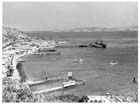 |
AWM 025948 (Australian War Memorial)
Militiamen (some as young as 16) of the 23rd Heavy Anti-Aircraft Battery pose by one of their four 3.7-inch static AA guns, August 1942. This unit was rushed to Port Moresby in January 1942 in a frantic effort to strengthen the harbour’s defences after the outbreak of the Pacific War. | 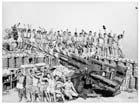 |
AWM P02018.1 (Australian War Memorial)
The Owen Stanley Ranges south of Kokoda taken from a RAAF aircraft flying at 25,000 feet. The tangle of mountains, ridges and gorges, with dense humid jungle and rainforest, combined to create a formidable natural obstacle. Nonetheless Major General HORII Tomitaro and the men of the South Seas Force were determined to cross it and capture Port Moresby. | 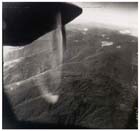 |
AWM 006217 (Australian War Memorial)
Men of the Papuan Infantry Battalion on parade in Port Moresby, January 1941. This militia unit had only been formed in June 1940 and was a battalion in name only – by 1942 only three companies had been raised and these were all understrength by normal Australian standards. Sent forward in June 1942 to patrol the northern Papuan coast the unit, further weakened by its dispersal over a wide area, was effectively swept away by the subsequent Japanese advance inland from Buna. | 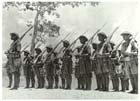 |
AWM 128400 (Australian War Memorial)
Kokoda, August 1942. The airstrip is plainly visible while the village and other features have been labeled. Kokoda was the only airstrip between Port Moresby and Buna. For the Australians its name came to symbolise the bitter fighting that took place across the Owen Stanley Ranges between July and November 1942. For the Japanese the campaign was known simply as the ‘Port Moresby Offensive’ in keeping with the original goal of their attack. |  |
AWM 013289 (Australian War Memorial)
Weary and battered survivors of the 39th Battalion, AMF, September 1942. This inexperienced militia unit bore the brunt of the initial Japanese thrust through Kokoda in July, and was then constantly engaged in the desperate Australian retreat throughout August and into September. |  |
AWM 13290 (Australian War Memorial)
Australian troops heading back down the line along a track thick with mud and slush. This was typical of the conditions underfoot and was just one element of the physically exhausting environment the soldiers of both sides had to contend with. |  |
AWM 026314 (Australian War Memorial)
Carrier lines manned by Papuan and New Guinean labourers were quickly established by both the Australians and Japanese. Snaking their way up the treacherous trails and tracks of the Owen Stanleys these men provided the fragile lifeline through which rations, equipment and ammunition reached the fighting troops. |  |
AWM 026715 (Australian War Memorial)
Men of the Royal Australian Engineers felling and sawing trees with which to bridge small creeks or streams along the main track to Kokoda, August 1942. While little could be done about the steep mountainsides and plummeting ravines small improvements like this were made wherever possible. |  |
AWM 026279 (Australian War Memorial)
A United States Army Air Force C-47 Dakota transport plane being loaded with supplies for the Australian troops near Kokoda, August 1942. Air drops were the only alternative to the carrier lines on the ground. Unfortunately a shortage of transport aircraft, and the high wastage associated with the early air dispatch methods used, meant that the Australians had to rely primarily upon their Papuan carriers for the duration of the campaign. |  |
AWM 013256 (Australian War Memorial)
In addition to bringing up supplies Papuans also played a vital role in bringing out the Australian sick and wounded. The difficulty involved in the latter task is vividly illustrated here by the number of men needed to carry a stretcher case across a mountain stream in September 1942. |  |
AWM 003672 (Australian War Memorial)
Another example of Papuan stretcher bearers carrying a casualty through the rugged terrain of the Owen Stanleys (note the steep gradient of the track). The efforts of these Papuans was lauded at the time by both Allied propaganda and the Australian troops themselves, who nicknamed them the ‘Fuzzy Wuzzy Angels’. |  |
AWM 026704 (Australian War Memorial)
Infantry of the 25th Brigade disembarking from troopships at the wharf in Port Moresby in September 1942. Despite having pushed the Australians all the way back to the last ridge line before Port Moresby, General HORII’s brave but exhausted men were finally stopped by this injection of fresh Australian troops. |  |
AWM 026715 (Australian War Memorial)
Three survivors of the 2/14th Battalion who emerged out of the jungle in October 1942 after being cut off from their unit during the August fighting around Isurava and Alola. They spent 42 days in the jungle and survived with the help of friendly Papuans. This help included the provision of a Papuan raft (which they are sitting on) that allowed them to complete the last leg of their journey back to Allied lines. Many of their compatriots in the same situation were not so lucky and were never seen again. | 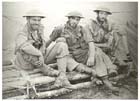 |
AWM ART23520 (Australian War Memorial)
George Browning, Uberi Village, Kokoda Trail,, 1944, oil on canvas on plywood,40.4 x 45.3 cm, Australian War Memorial ART23520. | 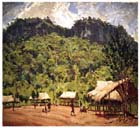 |
AWM ART23615 (Australian War Memorial)
George Browning, 25 Brigade advancing along Kokoda Trail near Templeton's Crossing, 1944, oil on canvas on plywood, 51.6 x 62.2 cm, Australian War Memorial ART23615. |  |
AWM ART26653 (Australian War Memorial)
William Dargie, Stretcher bearers in the Owen Stanleys, 1947, oil on canvas, 143.2 x 234.4 cm, Australian War Memorial ART26653 |  |
 Overview text
Overview text Longer text
Longer text  Images
Images  Readings
Readings  Albert Moore
Albert Moore  Arnold Potts
Arnold Potts  Harvey Blundell
Harvey Blundell  Kiki Baiyane
Kiki Baiyane  Map
Map Overview text
Overview text Longer text
Longer text  Images
Images  Readings
Readings  Albert Moore
Albert Moore  Arnold Potts
Arnold Potts  Harvey Blundell
Harvey Blundell  Kiki Baiyane
Kiki Baiyane  Map
Map